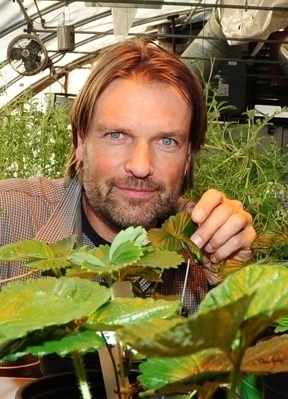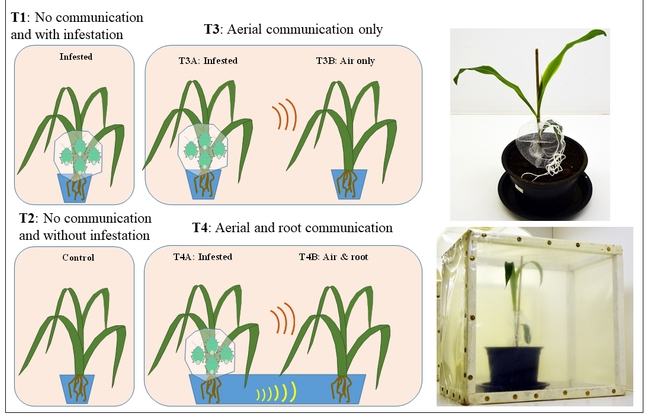
They can also do something else.
Basically, if you're a plant and an insect is attacking you, you can communicate your stress to nearby plants as a way to alert them about potential danger--very similar to how animals communicate or respond to predators, according to UC Davis agricultural entomologist Christian Nansen of the Department of Entomology and Nematology.
In groundbreaking research published in the journal Plant Methods, Nansen and his team of six colleagues from Brazil discovered that plant-plant communication causes physiological changes in plants and these subtle changes can be detected via analyses of leaf reflectance or hyperspectral imaging. The article is titled “Hyperspectral Imaging to Characterize Plant-Plant Communication in Response to Insect Herbivory."
The growing knowledge about plant-plant communication and about plants' ability to assess their environment has led to concepts like “plant neuro-biology” and “plant behavior,” said Nansen, an associate professor who centers his research on host plant-stress detection, host selection by arthropods, pesticide performance, and use of reflectance-based imaging in a wide range of research applications.
“We know that plants don't have a neural system or brain,” said Nansen, “but respected scientists are studying plants as if they did, as if plants are able to assess conditions in their environments, and they can adapt/respond to those conditions.”
“In studies of plant stress signaling, a major challenge is the lack of non-invasive methods to detect physiological plant responses and to characterize plant-plant communication over time and space.” Nansen pointed out. He described the research as “initial evidence of how hyperspectral imaging may be considered a powerful non-invasive method to increase our current understanding of both direct plant responses to biotic stressors but also to the multiple ways plant communities are able to communicate.”
The UC Davis entomologist and his team used leaf reflectance data to detect and characterize plant responses to stressors, knowing that induced stress interferes with photosynthesis, chemical composition and physical structure of the plant, thus affecting the absorption of light energy and altering the reflectance spectrum of the plants.
“For several decades, it has been known that plants communicate – both among individuals of the same species and across species,” Nansen related. “That is, volatiles emitted by one plant can be received by another plant and trigger different physiological responses. It is also well-documented that plants communicate via roots, and sometimes the roots from different plants are brought together in a network of communication and exchange of nutrients through symbioses with mychorriza (soil fungi).”
Of the Nansen study, Karban said: "This study describes a technique that may provide a relatively quick and inexpensive way to evaluate levels of resistance in plants. If these results are repeatable by other workers in other systems, they will provide a very valuable tool for researchers and growers."
Both Karban and Nansen contributed chapters to the recently published book, The Language of Plants (University of Minnesota Press). The book explores "the idea that plants can think, feel, and communicate as a way of reconfiguring our relationship with the natural world," according to editors Monica Gagliano, John C. Ryan, and Patrícia Vieira.
"Within the last decade or so, extremely cutting-edge research in the field of plant-plant communication has been done by people like Dr. Monica Gagliano of the University of Western Australia," Nansen said. "She has elegantly demonstrated that plants can respond not only to aerial volatile compounds and root secretions but also to sound."
For the research project, Nansen and his team decided to conduct “a very simple experiment with corn plants and stink bugs.” They planted corn plants in separate pots or two in one pot. They subjected some plants to herbivory by stink bugs, while other plants served as control plants.
The scientists collected two types of data: phytocompounds (stress hormones and pigments) and leaf reflectance data (proximal remote sensing data).
“Our research hypothesis was that insect herbivory causes changes in leaf phytocompound levels, and these physiological defense responses are associated with detectable changes in phytocompound levels and in certain spectral bands of leaf reflectance profiles,” Nansen pointed out. As a secondary hypothesis, the researchers predicted that plant-plant communication (from plant with herbivory to an adjacent control plant without herbivory) will elicit both a change in phytocompound composition of leaves and also cause a corresponding change in leaf reflectance.
The result: The first published study, in which comprehensive phytocompound data have been shown to correlate with leaf reflectance. In addition, it is the first published study of leaf reflectance in plant-plant communication.
Nansen and co-author Leandro do Prado Ribeiro of the Research Center for Family Agriculture, Research and Rural Extension Company of Santa Catarina, Brazil, conceived and designed the experiments. The Brazilian National Counsel of Technological and Scientific Development provided partial financial support. Co-author Marilia Almeida Trapp received financial support from a Capes-Humboldt Research Fellowship.
Attached Images:
